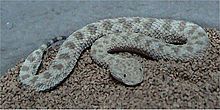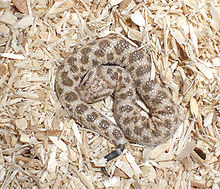- Cerastes vipera
-
Cerastes vipera 
Scientific classification Kingdom: Animalia Phylum: Chordata Subphylum: Vertebrata Class: Reptilia Order: Squamata Suborder: Serpentes Family: Viperidae Subfamily: Viperinae Genus: Cerastes Species: C. vipera Binomial name Cerastes vipera
(Linnaeus, 1758)Synonyms - [Coluber] vipera - Linnaeus, 1758
- Aspis Cleopatrae - Laurenti, 1768
- Vipera Aegyptia - Latreille In Sonnini & Latreille, 1801
- Vipera aegyptiaca - Daudin, 1803
- Aspis Cleopatra - Gray, 1842
- Cerastes Richiei - Gray, 1842
- Echidna atricauda - Duméril, Bibron & Duméril, 1854
- Vipera Avicennae - Jan, 1859
- V[ipera]. (Echidna) Avicennae - Jan, 1863
- Vipera avizennae - Strauch, 1869
- Cerastes vipera - Boulenger, 1891
- Cerastes vipera - Boulenger, 1896
- Cerastes vipera inornatus - Werner, 1929
- Aspis vipera - Kramer & Schnurrenberger, 1959
- Cerastes vipera - Joger, 1984[1]
Cerastes vipera is a venomous viper species found in the deserts of North Africa and the Sinai Peninsula. No subspecies are currently recognized.[3]
Contents
Description
Averages 20-35 cm (8-14 in) in length, with a maximum of 50 cm (1.6 ft). Females are larger than males.[2] Small and stout, it has a broad, triangular head with small eyes set well forward and situated on the junction of the side and the top of the head. A true desert species. Its said that Cleopatra committed suicide using an Egyptian Asp[2][4]
Common names
Sahara sand viper, Avicenna viper,[2] common sand viper,[5] Egyptian asp, Cleopatra's asp, sand viper,[6] Avicenna's sand viper, lesser cerastes.[7]
Geographic range
Found in arid North Africa: Mauritania, Morocco, Algeria, Mali, Tunisia, Libya, Niger, Chad and Egypt. Sinai Peninsula: Egypt and Israel. The type locality given is "AEgypto" (Egypt).[1]
See also
- List of viperine species and subspecies
- Viperinae by common name
- Viperinae by taxonomic synonyms
- Snakebite
References
- ^ a b McDiarmid RW, Campbell JA, Touré T. 1999. Snake Species of the World: A Taxonomic and Geographic Reference, vol. 1. Herpetologists' League. 511 pp. ISBN 1-893777-00-6 (series). ISBN 1-893777-01-4 (volume).
- ^ a b c d Mallow D, Ludwig D, Nilson G. 2003. True Vipers: Natural History and Toxinology of Old World Vipers. Krieger Publishing Company, Malabar, Florida. 359 pp. ISBN 0-89464-877-2.
- ^ "Cerastes vipera". Integrated Taxonomic Information System. http://www.itis.gov/servlet/SingleRpt/SingleRpt?search_topic=TSN&search_value=634965. Retrieved 30 July 2006.
- ^ Spawls S, Branch B. 1995. The Dangerous Snakes of Africa. Ralph Curtis Books. Dubai: Oriental Press. 192 pp. ISBN 0-88359-029-8.
- ^ Gotch AF. 1986. Reptiles -- Their Latin Names Explained. Poole, UK: Blandford Press. 176 pp. ISBN 0-7137-1704-1.
- ^ Brown JH. 1973. Toxicology and Pharmacology of Venoms from Poisonous Snakes. Springfield, Illinois: Charles C. Thomas. 184 pp. LCCCN 73-229. ISBN 0-398-02808-7.
- ^ U.S. Navy. 1991. Poisonous Snakes of the World. US Govt. New York: Dover Publications Inc. 203 pp. ISBN 0-486-26629-X.
External links
- Cerastes vipera at the Reptarium.cz Reptile Database. Accessed 2 August 2007.
Categories:- Viperinae
- Reptiles of Morocco
Wikimedia Foundation. 2010.

